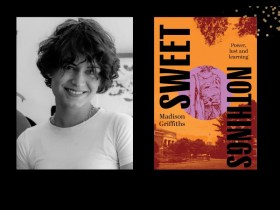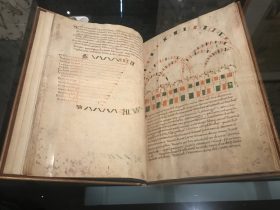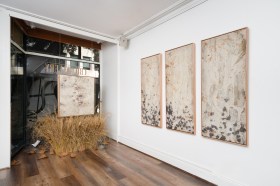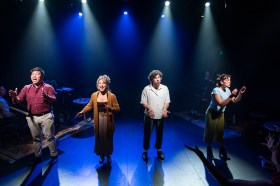After my last column, I have received a few criticisms. Apparently I was at least a little misinformed, and seemed to make a habit of ‘bashing’ Polyglot. I would just like to say for the record: I was not bashing Polyglot. I did not enjoy their performance. That does not mean to say that their entire work history is bad. I’m just writing what I have observed. And if I sounded at all ignorant or misinformed or unaware of the puppetry industry in general, well, that’s because that was my point.
Because I am incredibly uninformed about puppetry, and in my writing was trying to point out my lack of having accessible information about the craft. I am sure that there are plenty of puppeteers who are upset with me about this column, and all I can say is good. Because my column intended to point out the lack of information I had.
By proving my ignorance, I was making a statement about the general difficulties it is to break into this area, with such a hard time finding information, people in the know, money to do all of it, and access to professional companies. However, my recent trip to Korea has, at least, given me more experience in the puppetry world, if not a better understanding of it.
My trip to Korea started off, well… let’s just say, kind of heart-thumping. That is to say, when I got off the plane in Ho Chi Minh for a seven hour stop over, an airport worker asked if she could talk to me…and promptly took me aside. In this day and age, your mind quickly races over the things that could be wrong…them telling me they couldn’t provide a kosher meal for the next leg of the trip was not one of them! (You don’t want to know what they did on the way back to Melbourne…that was cruel, yet satisfying…they boosted me to business class! After telling me there was something wrong with my ticket.)
We (for I went with a friend) stayed in Seoul for a few days, shopping and spending what seemed to be large amounts (the currency, won, is in thousands, so $1000 won would be roughly under an Australian dollar) on stationary and the like, and generally sweated in the 30 degree heat. On the third day, we travelled for about three hours to a city northeast of Seoul, Chuncheon (pronounced, as I have now learned, ‘Choonchun’) where the puppetry festival is held.
Now, I and my friend had in fact volunteered to work at Chuncheon Puppet Festival 2004, so we were arriving three days before the actual festival started. We were given accommodation in a local dorm, plus three free meals each day, two t-shirts each, a name tag, and a hat each. Included in all of this were two complimentary tickets each for our friends or family, and of course, if we wanted to see any show at any time, we could go in for free. Sounds pretty good, doesn’t it?
Unfortunately, my Korean was not even remotely close to fluent, and I was (or at least as far as I know) the only non-Korean volunteer. So this means that I spent most of my time attached to the ‘official’ (volunteered) translators, and seeing a lot of shows on my own. My friend was stage manager for one of the venues, and as such, couldn’t spend any time with me.
This was both good and bad. I could wander around and enjoy myself, by seeing the shows – which was after all, why I had gone – however, being a volunteer sort of requires you to do some work, especially as they were paying for me to be there. But my Korean and their English was just not up to it. Nevertheless, I did some vague work – cutting signs, helping the translators with the international groups (attending were Bulgarian, Russian, English, Italian and Japanese puppeteers), and even doing some basic editing and proofreading for some of the festival publications.
Anyway, the first day I was there, I got suckered into a most unusual job. I say suckered, but really, who else was going to do it? I was asked to record in English, the announcement before each show. There was also a Korean counterpart, which was recorded by another girl. So, my voice became the English ‘voice of the festival.’ I couldn’t stand it after a while, because it was everywhere I went. You think you sound bad on a tape or home movie – imagine listening to it through a theatre’s PA system!
The venue itself is not a venue as such, it’s an entire campus. There is parking of course, but the place consists of the Chuncheon Puppet Theatre, which has the HQ’s inside, plus rehearsal rooms, and a 500 seating capacity theatre. Across from that is a small amphitheatre which looks out across the town’s lake. Then there is the newly opened museum, containing puppets from all over the world and a special area where you can have a go at marionettes and Punch and Judy. The museum building also holds a café, and downstairs there are two rooms, which were done up to be theatres. They were no bigger than say, a 60 seating capacity each. Outside, behind that building is the tent, with 100 or so seating capacity. There was also an outside stage, where there were performances at night, and special acts.
My first night of the festival, I was treated to some spectacular fireworks, and some puppetry about a traditional tale (it was explained to me, but I wouldn’t explain it to others very well). I also got to see a very rare collection of stamps that were on show in the museum, courtesy of an Italian collector. Each stamp had a significant puppetry moment contained in it – even one of Sooty!
Once the festival got under way, I felt more relaxed. Most of the other volunteers had jobs to do, and I felt bad for not being more involved, but I soon discovered I couldn’t be even if I wanted to. My Korean just wasn’t up to scratch. So after three days of being a little bored, the puppets were a welcome distraction. The first two days, I watched parts of the amateur competition. This was extremely interesting…or at least it promised to be. I think I may have watched about 20 shows, performed by different groups. Many of them (as puppetry is aimed mainly at children) were about kids meeting a bad person, and overcoming the evil, or about kids who go on adventures, or about kids who learn lessons and become good. Needless to say, it became a little repetitive.
It was also interesting to see that most of the puppetry was in the form of rods, with the operators working ‘below’ – a ‘hide’ or short wall is placed in front of the performers, at the front of the stage, and the puppets rise up behind it, held up by the rods. Many of the amateur performances were of relative quality, the puppets being nice to look at, but didn’t enthuse the audience (it’s hard to judge a show, when the dialogue is incomprehensible to you), but there were a few that were not only beautiful, but employed some imaginative uses of the puppets themselves and the setting around them.
The next day, I managed to see what became my favourite show of the festival. Ironic, as I originally saw the image of the show in the festival program, and thought I wouldn’t enjoy it. I wasn’t planning on seeing it, but as the couple performing the show were Italian, and I was helping the translator that day, I attended.
This performance consisted of Laura Kibel, the puppeteer, manipulating her feet! She would dress up her legs and feet with costumes, and produce hilarious and amazingly dexterous and expressive characters and storylines. She set up a number of suitcases, each with different characters and stories, and
performed them one by one for an hour’s show. I ended up seeing this performance twice, as my friend had some time off, and went with another friend. I was thrilled to see it again, as I spent most of my time in shows taking notes, and wanted to see it without the distraction. To my delight, she introduced two pieces which I hadn’t seen previously. She received a huge amount of applause from the audience, and so she should; it was not only enjoyable and intriguing to watch, but without dialogue, appealed to everyone in the audience.
The performances, spread over nine days, were in fact, numerous, despite the number of actual venues. Each performance would bump in, in the evening, and perform over two days. They would bump out, and the next group would come in.
Because my friend was working in one of the venues, I generally sat in on those shows, and the ones across the hall (she was working in one of the rooms under the museum). Unfortunately, or fortunately, most of the shows in there were Korean. Which meant more kids being bad and then learning their lesson, or more adventures in new places, or more overcoming bad guys. I watched a total of nine of these shows (plus five other shows in other venues, two of which I saw twice). I guess on average I saw three or four shows a day. Anyway, most of the Korean shows consisted of either glove puppets, rod puppets (operated from beneath) or ‘suits’/costumes in the style of pantomimes. The next show that I saw was one of these Korean productions that were so-so.
But the show after that was supposed to be better. It was the St Petersburg State Puppet Theatre from Russia. These guys were supposed to be good, but I had heard that one of their previous productions (which was presented in Melbourne) was not that great. I did not hold that against them.
Not having seen much marionette work before, I enthusiastically went in, only to be surprised. Many of the audience members had fallen asleep by the end of the performance (one hour roughly), but then, many audience members did that in pretty much any performance I attended. What surprised me even more, is that while I was sure that the performance was technically impressive, what with the marionettes performing circus tricks, that seemed only possible without the strings attached, it wasn’t attention grabbing enough. Many of the sections of the show (as with ‘live’ circus, it was split into acts) were repetitive, and for the audience, awfully slow. As I said, it’s clear that the puppeteers have a challenge while performing, but from an audience’s point of view, it didn’t keep me wanting to watch. By the end, I was playing spot-the-puppeteer-behind-the-set. It also had playful yet annoying breaks between set changes, performed by actual (read: human) clowns. These were cute, but there was so many of them, it quickly got tired. I hate to say it, but this was not in my favourites. I did enjoy it on a professional level, but as a lay-person, it was not the best.
The next day, I saw another two Korean performances, one of the adventure kind, and the other of the bad-kid-turned-good. The second was quite nice, being performed by a husband and wife, and began not with the show’s storyline, but with a scenelet in the park, in which the rest of the show was set. This scenelet was performed, instead of from below, like later in the performance, but from a section cut out of the ‘hide.’ It was also operated with clear view of the puppeteers, and by the puppets natural extremities and occasional rod from the side. The way they performed was nice, with relaxed composure and a feeling of taking their time, of allowing the puppets to move them. Many of the other performances didn’t have this sense of timing, but rather moved as if constant jerky movements could make the puppet come to life. One of the few things that I have learned about puppetry is that less is more. And this couple used that theory wonderfully.
Then I saw a pantomime in the amphitheatre. I didn’t understand one word of it, but even pantomime is easy to follow. Suffice it to say, it was too much for the kiddies for me to enjoy it thoroughly, especially as it required following the dialogue.
My presence at the festival was becoming more and more of a public thing. I soon became introduced to most of the notable people who run the festival. Everybody was extremely welcoming, and despite the confusion of language barriers, everybody treated me with such politeness and friendliness that sometimes I forgot that I didn’t understand what they were saying.
In fact, by the time I left the festival, I had an interview with one of the local papers – well, that is to say, the reporter asked a few basic questions in English, and would then write a bit about it. I guess because I was a volunteer, I was unusual. The only other international guests were the international puppeteers, who quickly left once their shows were over, and a few audience members from the US.
The third day of the festival I saw another Korean performance – kid, or this time, fox, overcomes the evil guy. More rod puppets and suits, and more pantomime. Many of the companies overused the lighting technique ‘chase’ (when lights are flashed randomly), and by the end of this particular performance, wondered whether the audience should have been given warning, as many of the chases could have qualified as strobe lighting.
Nevertheless, I was quickly entertained by the short, yet unique Lejo. This performance was done by one man from the Netherlands. This man used a specially designed ‘hide’ – a thin, tall ‘wall’ with a little window cut out at the top. In this window, he performed using his own hands, attached with small ‘eyeballs.’ There were about three pieces, and the performance only lasted ten minutes.
Each piece was masterfully done, and reminded me of a smaller version of the woman from Italy. The hands performed magic tricks, playing an invisible piano, and general antics. The hands were amazingly infused with character, and every movement leant itself to these characters. This was so enjoyable, and so quick, that I saw it twice.
This brings me to the next show, a performance by Koreans. This was in the main theatre, and was in fact, marionettes.
The story was roughly about a young boy, who wants to be a painter, and travels to see a famous painting. He has a grandfather, and a girlfriend, but his grandfather dies. He sends his paintings into a competition, but loses, and ends up losing faith in his work. He goes to the famous painting…and from there I got lost.
It was a very beautiful production, and my favourite out of all the Korean performances. The timing was slow, but not so slow you got bored. The puppeteers took their time, and even from far in the back rows, I could tell that the staging was well done.
After this, I saw Puss in Boots, although why there was a strange, magical monkey/evil guy in the middle of it, I don’t know. But the next day, I was again lifted by another international production, by Bulgarian puppeteers.
This was called Buratino, and was about a puppeteer whose puppets are taken by a man to show to an evil and demanding master. This puppeteer then creates a new puppet, which saves the others from the evil master. These were beautiful marionettes, and performed on a small turntable, with fabric and set pieces that could be rotated to create a new setting. I unfortunately saw their first showing of this performance, and upon speaking to the performers later, discovered that this showing was not as good as their later one. I was though, very impressed, and thought their staging was very innovative. It could not have been bigger than 1m square in diameter, and maybe 1 and ½m high. The operation was magnificent, with performers operating more than one puppet at times, with great dexterity.
After this, I saw The Ugly Duckling, another Korean performance. I was very impressed with the colourful sets, and I’m sure I would have enjoyed it immensely had I understood all the dialogue.
This was my last day. I returned home earlier than expected, due to personal reasons. My last night, I spent enjoying the harmonic sounds of a rap/rock group on the outside stage. I had been convinced by one of the translators to go and see the music – especially as afterwards, we got to watch some traditional musicians perform. Finally, we went and sat in the amphitheatre, where the organisers had set up some chairs and tables, and where the international guests would perform short puppetry pieces, and traditional (to their particular country) songs. As part of this, every table was given cans of beer, snacks and sweets, watermelon and could partake in conversations with the puppeteers.
I was a bit disappointed early that morning, because I was leaving early. But by the end of the evening, I felt better about it. I left with such a feeling of friendship, handed to me by all the people I had met. Several organisers of the festival and other volunteers made a point of saying goodbye to me, even though they had not been introduced to me before.
I am going to return to the festival next year, hopefully with a show of my own, and hopefully with two of my friends. The whole trip actually, can be summed up in a weird experience I had on the way to the airport. As Chuncheon was a good three hours from the Incheon airport (just outside of Seoul), I spent much of the time in the car asleep.
But for a split second, I opened my eyes, and to my confusion I saw a ship. We were nowhere near the ocean, and the ship, upon more detailed observation, was in fact lodged firmly on the ground between some hills only imaginable of an Asian countryside. And written on this ship was the word Sydney. For a microsecond, I thought I was in the wrong country. But having wondered at this marvel, I promptly fell back to sleep. My trip was like that – something unusual and different, rising up out of my life, making me feel as though I were in a different world to my own, and yet reminding me of home.




